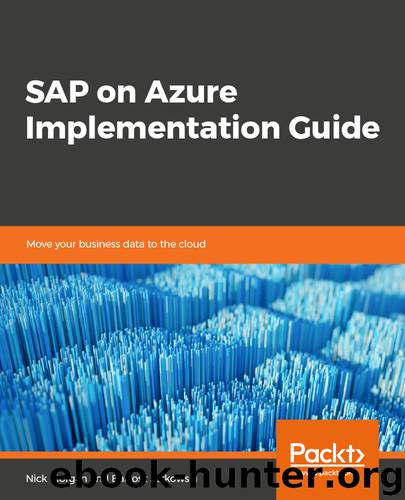SAP on Azure Implementation Guide by Nick Morgan && Bartosz Jarkowski

Author:Nick Morgan && Bartosz Jarkowski
Language: eng
Format: epub
Tags: COM088000 - COMPUTERS / System Administration / General, COM061000 - COMPUTERS / Client-Server Computing, COM051000 - COMPUTERS / Programming / General
Publisher: Packt
Published: 2019-12-12T08:35:34+00:00
SAP S/4HANA and SAP Fiori
SAP S/4HANA is the new business solution and a direct successor of SAP ERP, also known as SAP ERP Central Component (ECC). The business processes have been redesigned and the business model has been simplified, but there is an additional important change. The recommended user interface is changed from SAP GUI to SAP Fiori, which means the system should be accessed through a web browser instead of a dedicated client. The SAP GUI can still be used with S/4HANA, and if you are planning a conversion (technical upgrade) of an existing ECC system to S/4 and you want to minimize user impact, then this is a valid solution.
While such change may not appear very significant, it has a major impact on the overall system architecture. SAP Fiori may be combined with SAP S/4HANA, which is called an embedded deployment and it is the recommended scenario from SAP when it will be used exclusively with S/4HANA. However, SAP Fiori can also be deployed as a completely separate system, with its own application servers and database. This is referred to as a hub deployment and is mostly used when a single SAP Fiori will provide access to multiple back-end SAP systems.
SAP Fiori is, in fact, an application based on NetWeaver AS ABAP and a database, and if it is deployed as a separate system, it has to follow all the recommendations as per normal SAP NetWeaver-based systems, including sizing and resilience. If high availability is planned for the backend system, it must also be considered for the front-end. Otherwise, in the event of an unexpected downtime of Fiori, users will not be able to access the back-end application even if it is still up and running.
The separate SAP Fiori system usually does not store a lot of data in the database and acts as a proxy between the user and back-end system. Therefore, to optimize the solution, its database can be stacked together with the back-end system database. Such optimization is especially useful when SAP HANA is the database. The certified hardware for SAP HANA is expensive, so stacking the databases together using SAP HANA Multitenant Database Containers (MDCs) will decrease the cost of hosting Fiori.
While it is technically possible to use another DBMS for SAP Fiori, since SAP intends to end support for other DBMSes except SAP HANA as of 2025, this is only a short-term solution, and within a few years, the Fiori system will have to be migrated to HANA.
SAP Fiori is accessed through the HTTP protocol and it is good practice to add an extra security layer. SAP Web Dispatcher is a reverse-proxy that can be placed between a user and the system. It can accept or reject a user connection and load balance traffic between multiple application servers. SAP recommend using the Web Dispatcher in front of the Fiori system.
The SAP Web Dispatcher should be deployed in the DMZ area of the network. The VM hosting the reverse proxy should have two network adapters – one for user connections and the second for communications with the SAP Fiori server.
Download
This site does not store any files on its server. We only index and link to content provided by other sites. Please contact the content providers to delete copyright contents if any and email us, we'll remove relevant links or contents immediately.
Algorithms of the Intelligent Web by Haralambos Marmanis;Dmitry Babenko(8517)
Building Statistical Models in Python by Huy Hoang Nguyen & Paul N Adams & Stuart J Miller(7293)
Azure Data and AI Architect Handbook by Olivier Mertens & Breght Van Baelen(7291)
Serverless Machine Learning with Amazon Redshift ML by Debu Panda & Phil Bates & Bhanu Pittampally & Sumeet Joshi(7179)
Data Wrangling on AWS by Navnit Shukla | Sankar M | Sam Palani(6942)
Driving Data Quality with Data Contracts by Andrew Jones(6922)
Machine Learning Model Serving Patterns and Best Practices by Md Johirul Islam(6666)
Learning SQL by Alan Beaulieu(6152)
Weapons of Math Destruction by Cathy O'Neil(6075)
Big Data Analysis with Python by Ivan Marin(5687)
Data Engineering with dbt by Roberto Zagni(4680)
Solidity Programming Essentials by Ritesh Modi(4341)
Time Series Analysis with Python Cookbook by Tarek A. Atwan(4180)
Pandas Cookbook by Theodore Petrou(3903)
Blockchain Basics by Daniel Drescher(3418)
Hands-On Machine Learning for Algorithmic Trading by Stefan Jansen(2953)
Natural Language Processing with Java Cookbook by Richard M. Reese(2909)
Feature Store for Machine Learning by Jayanth Kumar M J(2857)
Learn T-SQL Querying by Pam Lahoud & Pedro Lopes(2842)
